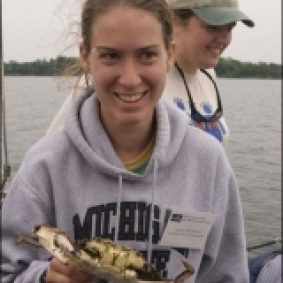Eight students will be presenting the summer work at the Ocean Sciences Meeting in March 2022!
Audrey McDonald, Colorado State University
Class Year:
2006Mentor:
Carys Mitchelmore, Ph.D.Project Title:
Assessing Acute and Sub-Lethal Effects of Physically and Chemically Dispersed Oil on the Soft Coral Xenia elongata
Abstract:
In the event of an oil spill, timely and informed response decisions must be made based on sound scientific research. In coastal areas, shallow water and rocky shoals serve as barriers to the use of recovery equipment and leave coastal life vulnerable to surface slicks. Dispersants could provide a solution to this problem; however, careful research must be conducted to determine the effects on benthic and water column life. This research studied the effects of chemically dispersed oil on the sensitive symbiotic soft coral Xenia elongata to determine toxicity levels in this common cnidarian. Three experiments were conducted testing the acute and sub-lethal toxicity of water accommodated fractions of Arabian Light crude oil (WAF), chemically enhanced water accommodated fractions (CEWAF), as well as the toxicity of the dispersant alone. A multi-tiered array of behavioral and physical endpoints were analyzed including pulse rate, pulse intensity, rigidity, as well as physical measurements of poly-aromatic hydrocarbons (PAHs), dissolved oxygen, chlorophyll content and DNA damage. The corals showed high sensitivity to both the chemically dispersed oil (CEWAF) and the dispersant alone. LC50s for dispersant alone were in the 50-60 range and concentrations at 25 ppm and higher produced strong adverse behavioral responses. In the acute experiment, 20 ppm dispersant treatments and CEWAF treatments at the 1 g oil/L with a 1:20 dispersant to oil ratio produced a complete paralysis of pulsing. All showed significant recovery in clean artificial sea water within two weeks with CEWAF treatments resulting in the slowest recovery. Chlorophyll levels and algal cell counts did not differ significantly between treatments when normalized to protein levels although there were lower levels of both protein and chlorophyll overall in the high acute CEWAF treatments. Further analysis of water and tissue samples will illuminate PAH uptake and accumulation levels as well as assess levels of DNA damage.
Location:
Chesapeake Biological LaboratoryPresentations:
McDonald, A.*. 2006. Acute and sub-lethal effects of chemically and physically dispersed oil on the soft coral . Undergraduate Research Symposium, Colorado State University, Fort Collins, Colorado .




